Construction of a prognostic assessment model for colon cancer patients based on immune-related genes and exploration of related immune characteristics
- PMID: 36589748
- PMCID: PMC9800979
- DOI: 10.3389/fcell.2022.993580
Construction of a prognostic assessment model for colon cancer patients based on immune-related genes and exploration of related immune characteristics
Abstract
Objectives: To establish a novel risk score model that could predict the survival and immune response of patients with colon cancer. Methods: We used The Cancer Genome Atlas (TCGA) database to get mRNA expression profile data, corresponding clinical information and somatic mutation data of patients with colon cancer. Limma R software package and univariate Cox regression were performed to screen out immune-related prognostic genes. GO (Gene ontology) and KEGG (Kyoto Encyclopedia of Genes and Genomes) were used for gene function enrichment analysis. The risk scoring model was established by Lasso regression and multivariate Cox regression. CIBERSORT was conducted to estimate 22 types of tumor-infiltrating immune cells and immune cell functions in tumors. Correlation analysis was used to demonstrate the relationship between the risk score and immune escape potential. Results: 679 immune-related genes were selected from 7846 differentially expressed genes (DEGs). GO and KEGG analysis found that immune-related DEGs were mainly enriched in immune response, complement activation, cytokine-cytokine receptor interaction and so on. Finally, we established a 3 immune-related genes risk scoring model, which was the accurate independent predictor of overall survival (OS) in colon cancer. Correlation analysis indicated that there were significant differences in T cell exclusion potential in low-risk and high-risk groups. Conclusion: The immune-related gene risk scoring model could contribute to predicting the clinical outcome of patients with colon cancer.
Keywords: colon cancer; immune cell infiltration; immune escape; immune-related gene; risk model.
Copyright © 2022 Wan, He, Yang, Cheng, Li, Zhang, Zhang, Dai, Yu, Li, Xiong and Wan.
Conflict of interest statement
The authors declare that the research was conducted in the absence of any commercial or financial relationships that could be construed as a potential conflict of interest.
Figures
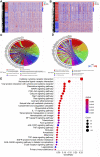
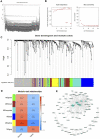
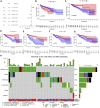
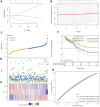

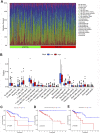
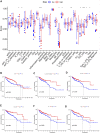

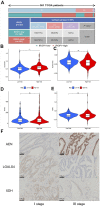
Similar articles
-
An Intratumor Heterogeneity-Related Signature for Predicting Prognosis, Immune Landscape, and Chemotherapy Response in Colon Adenocarcinoma.Front Med (Lausanne). 2022 Jul 7;9:925661. doi: 10.3389/fmed.2022.925661. eCollection 2022. Front Med (Lausanne). 2022. PMID: 35872794 Free PMC article.
-
A novel mitochondria-related gene signature in esophageal carcinoma: prognostic, immune, and therapeutic features.Funct Integr Genomics. 2023 Mar 29;23(2):109. doi: 10.1007/s10142-023-01030-2. Funct Integr Genomics. 2023. PMID: 36991225
-
Construction of a novel choline metabolism-related signature to predict prognosis, immune landscape, and chemotherapy response in colon adenocarcinoma.Front Immunol. 2022 Nov 14;13:1038927. doi: 10.3389/fimmu.2022.1038927. eCollection 2022. Front Immunol. 2022. PMID: 36451813 Free PMC article.
-
Identification of a glycolysis- and lactate-related gene signature for predicting prognosis, immune microenvironment, and drug candidates in colon adenocarcinoma.Front Cell Dev Biol. 2022 Aug 23;10:971992. doi: 10.3389/fcell.2022.971992. eCollection 2022. Front Cell Dev Biol. 2022. PMID: 36081904 Free PMC article.
-
Identify potential prognostic indicators and tumor-infiltrating immune cells in pancreatic adenocarcinoma.Biosci Rep. 2022 Feb 25;42(2):BSR20212523. doi: 10.1042/BSR20212523. Biosci Rep. 2022. PMID: 35083488 Free PMC article. Review.
Cited by
-
Possible Implications of Obesity-Primed Microglia that Could Contribute to Stroke-Associated Damage.Cell Mol Neurobiol. 2023 Aug;43(6):2473-2490. doi: 10.1007/s10571-023-01329-5. Epub 2023 Mar 20. Cell Mol Neurobiol. 2023. PMID: 36935429 Free PMC article. Review.
References
LinkOut - more resources
Full Text Sources

